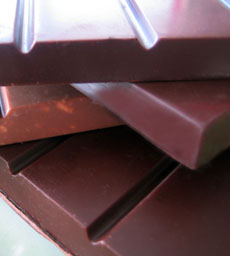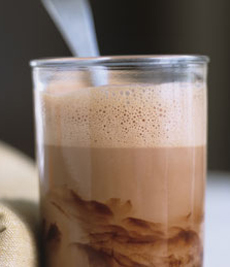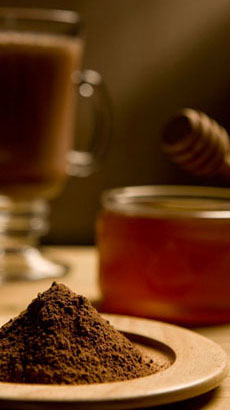This is Page 4a of a six-page article. Click on the black links below to visit other pages.
Chocolate Beverages And Health
Chocolate And Antioxidants
At least we all know that consuming chocolate in whatever form you choose is good for you, right? All those antioxidants hard at work…well, wait just a minute. It is true that cocoa is high in antioxidants, especially flavanols, a type of flavonoid. Antioxidants are commonly measured according to Oxygenated Radical Absorbance Capacity (ORAC) numbers. The ORAC measurement assigned to a food indicates total level of antioxidants, so a higher number indicates a greater quantity of antioxidants present.
One hundred grams (about 3.5 ounces) of dark chocolate has an ORAC number of thirteen thousand one hundred twenty (13,120), amazingly high among commonly-eaten foods. Even milk chocolate has a very respectable ORAC measurement of 6,740 for the same quantity.
Unhappily, you’re probably getting nowhere near that amount of chocolate in your chocolate beverage. Additionally, it’s important to remember that the ORAC number reflects a food’s overall antioxidant capacity and the time it takes to react as an antioxidant in a test tube. No one knows if antioxidants work similarly in the human body. And it appears that our systems are capable of absorbing a finite quantity of antioxidants in any given time period, so any excess may simply be excreted—meaning that a very high ORAC number isn’t always better for you.
|
|

We know chocolate is high in antioxidants; we just don’t know how much the human body needs for efficacy. Or, how to counterbalance the calories if, say, you need to eat 3.5 ounces of chocolate a day. Photo by Melody Lan | THE NIBBLE. |
Read more about this issue in our article on high-antioxidant foods.
Chocolate And Nutrition
Much of the research now being done on cacao (chocolate) is done on high-quality cocoa powder. It may be that our future “health drink” will be a flavonoid-enhanced cocoa powder with an artificial sweetener and fat-free milk, so as not to pack on the calories.
But today, cocoa is no health drink. Certainly, along with the antioxidants, what you’re getting with your hot cocoa or hot chocolate is some nutrition, especially if your drink is made with milk. Inescapably, though, you’re imbibing calories, sugar and fat (although cocoa butter is a heart-healthy fat), and often, significant sodium. Many manufacturers do not list nutrition information for their drinking chocolates and hot cocoas. This is doubtless to their benefit, as few Americans would rejoice in discovering what a steaming mug of hot chocolate or hot cocoa can add to their daily intake.
While L.A. Burdick Hot Chocolate, a NIBBLE Top Pick Of The Week, weighed in at 600 calories a cup (it’s virtually melted chocolate bars—and divine), there are “bargains” to be had. Nestlé Hot Cocoa Mix (Rich Chocolate) contains 80 calories, 3 grams of fat, 12 grams of sugar and 170 mg of sodium per serving when made with water. It’s hardly a rich, chocolatey experience. Lake Champlain’s New World Drinking Chocolate, a drinking chocolate made with milk, contains 145 calories, 11.5 grams of fat, 8 grams of sugar, and roughly 38 mg of sodium per serving—before you add the milk used to concoct the beverage. Add 90 calories for 8 ounces of fat-free milk or 150 calories for whole milk, and that’s 235 to 295 calories for the cup—as much as a serving of superpremium ice cream.
|
|

The milk in hot chocolate provides nutrition, but that doesn’t make it a “health drink.” Photo courtesy Recchiuti Confections. |
Got Additives?
On the other side of the health coin, that particular Lake Champlain preparation contains one ingredient—dark chocolate—while the Nestlé mix contains such delightful additives as corn syrup solids, partially hydrogenated and hydrogenated oils, sodium silicoaluminate, cellulose gum, dipotassium phosphate, sodium caseinate and artificial flavors, along with the basic sugar, cocoa processed with alkali and nonfat milk. So calories and fat grams aren’t the only story here. With supermarket brands, you’ll find additives; the “premium” brands generally don’t have them. Check the labels.
Work It Out
As with most sweets, hot chocolate and hot cocoa can absolutely be part of a sensible lifestyle. Eat a healthy diet, get in your exercise and enjoy the drinking chocolate of your choice as an occasional indulgence. Stop trying to justify the health claims and just settle back and delight in a mug. That’s what hot chocolate should be about, anyway: pure enjoyment.
Continue To Page 4b: Hot Chocolate As An Aphrodisiac
Continue To Page 5: Cocoa/Hot Chocolate Mixes
Go To The Article Index Above
Lifestyle Direct, Inc. All rights reserved. Photos are the copyright of their respective owners.






